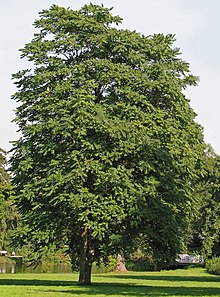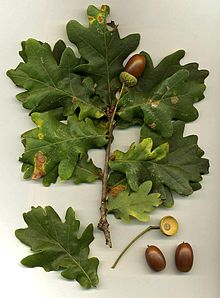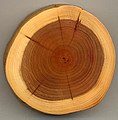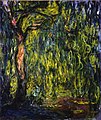Portal:Trees
The Trees Portal
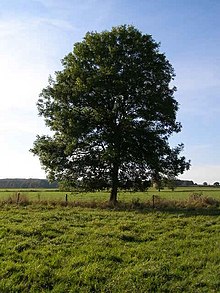
In botany, a tree is a perennial plant with an elongated stem, or trunk, usually supporting branches and leaves. In some usages, the definition of a tree may be narrower, including only woody plants with secondary growth, plants that are usable as lumber or plants above a specified height. In wider definitions, the taller palms, tree ferns, bananas, and bamboos are also trees.
Trees are not a monophyletic taxonomic group but consist of a wide variety of plant species that have independently evolved a trunk and branches as a way to tower above other plants to compete for sunlight. The majority of tree species are angiosperms or hardwoods; of the rest, many are gymnosperms or softwoods. Trees tend to be long-lived, some reaching several thousand years old. Trees evolved around 370 million years ago, and it is estimated that there are around three trillion mature trees in the world currently.
A tree typically has many secondary branches supported clear of the ground by the trunk, which typically contains woody tissue for strength, and vascular tissue to carry materials from one part of the tree to another. For most trees the trunk is surrounded by a layer of bark which serves as a protective barrier. Below the ground, the roots branch and spread out widely; they serve to anchor the tree and extract moisture and nutrients from the soil. Above ground, the branches divide into smaller branches and shoots. The shoots typically bear leaves, which capture light energy and convert it into sugars by photosynthesis, providing the food for the tree's growth and development.
Trees usually reproduce using seeds. Flowers and fruit may be present, but some trees, such as conifers, instead have pollen cones and seed cones. Palms, bananas, and bamboos also produce seeds, but tree ferns produce spores instead.
Trees play a significant role in reducing erosion and moderating the climate. They remove carbon dioxide from the atmosphere and store large quantities of carbon in their tissues. Trees and forests provide a habitat for many species of animals and plants. Tropical rainforests are among the most biodiverse habitats in the world. Trees provide shade and shelter, timber for construction, fuel for cooking and heating, and fruit for food as well as having many other uses. In much of the world, forests are shrinking as trees are cleared to increase the amount of land available for agriculture. Because of their longevity and usefulness, trees have always been revered, with sacred groves in various cultures, and they play a role in many of the world's mythologies. (Full article...)
Ailanthus altissima /eɪˈlænθəs ælˈtɪsɪmə/ ay-LAN-thəss al-TIH-sim-ə, commonly known as tree of heaven, Ailanthus, varnish tree, copal tree, stinking sumac, Chinese sumac, paradise tree, or in Chinese as chouchun (Chinese: 臭椿; pinyin: chòuchūn), is a deciduous tree in the family Simaroubaceae. It is native to northeast and central China, and Taiwan. Unlike other members of the genus Ailanthus, it is found in temperate climates rather than the tropics.
The tree grows rapidly, and is capable of reaching heights of 15 metres (50 ft) in 25 years. While the species rarely lives more than 50 years, some specimens exceed 100 years of age. Its suckering ability allows this tree to clone itself indefinitely. It is considered a noxious weed and vigorous invasive species, and one of the worst invasive plant species in Europe and North America. In 21st-century North America, the invasiveness of the species has been compounded by its role in the life cycle of the also destructive and invasive spotted lanternfly. (Full article...)Did you know? -
- ... that the Top 10 New Species of the past year include a 40 foot (12 m) tall tree (pictured), a crustacean that looks like a skeleton, a protist that acts like a sponge, and a fungus named after the King of the Netherlands?
- ... that the Pass Christian Light was deactivated in part because neighboring property owners refused to trim their trees?
- ... that Cossinia trifoliata trees endemic to New Caledonia have become vulnerable to extinction, according to the International Union for Conservation of Nature's 1998 assessment?
- ... that the Hanlon Expressway is named after Felix Hanlon, who helped cut the first tree to inaugurate Guelph, Ontario?
- ... that British architect Richard Feilden was killed by a falling tree whilst creating a woodland memorial for his recently deceased father?
- ... that according to tradition the Church of the Holy Archangels, Rogoz was built from two huge elm trees?
- ... that the oak tree under which Goethe allegedly wrote Faust's Walpurgis Night scene stood inside Buchenwald concentration camp and was sketched by French Volontaires de la Liberté member and camp inmate Léon Delarbre?
Selected article -
An oak is a hardwood tree or shrub in the genus Quercus of the beech family. They have spirally arranged leaves, often with lobed edges, and a nut called an acorn, borne within a cup. The genus is widely distributed in the Northern Hemisphere; it includes some 500 species, both deciduous and evergreen. Fossil oaks date back to the Middle Eocene. Molecular phylogeny shows that the genus is divided into Old World and New World clades, but many oak species hybridise freely, making the genus's history difficult to resolve.
Ecologically, oaks are keystone species in habitats from Mediterranean semi-desert to subtropical rainforest. They live in association with many kinds of fungi including truffles. Oaks support more than 950 species of caterpillar, many kinds of gall wasp which form distinctive galls, roundish woody lumps such as the oak apple, and a large number of pests and diseases. Oak leaves and acorns contain enough tannin to be toxic to cattle, but pigs are able to digest them safely. Oak timber is strong and hard, and has found many uses in construction and furniture-making. The bark was traditionally used for tanning leather. Wine barrels are made of oak; these are used for aging alcoholic beverages such as sherry and whisky, giving them a range of flavours, colours, and aromas. The spongy bark of the cork oak is used to make traditional wine bottle corks. Almost a third of oak species are threatened with extinction due to climate change, invasive pests, and habitat loss. (Full article...)General images
Selected lists
Subcategories
Related portals
Associated Wikimedia
The following Wikimedia Foundation sister projects provide more on this subject:
-
Commons
Free media repository -
Wikibooks
Free textbooks and manuals -
Wikidata
Free knowledge base -
Wikinews
Free-content news -
Wikiquote
Collection of quotations -
Wikisource
Free-content library -
Wikispecies
Directory of species -
Wikiversity
Free learning tools -
Wiktionary
Dictionary and thesaurus


